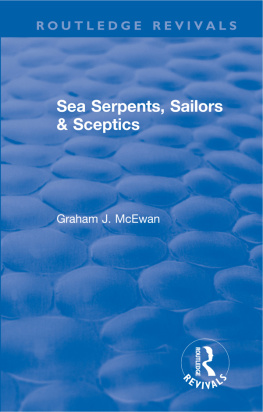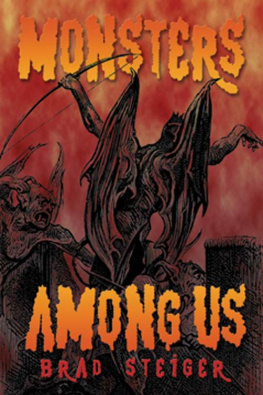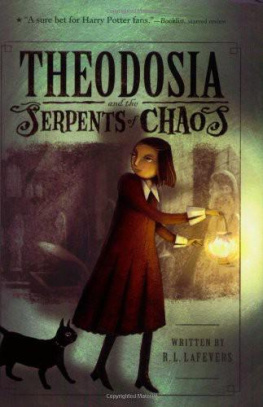Contents
Forgotten Sea Serpents
by
Malcolm Smith
Forgotten Sea Serpents
Independently published 2020
Copyright Malcolm Smith, 2020
This book is copyright. Apart from fair dealing for the purposes of private study, research, criticism or review, as permitted under the Copyright Act, no part may be reproduced by any process without written permission.
- Sea Serpents 2. Cryptozoology 3. Folklore.
4. Marine Mysteries
Cover illustration: contemporary (and probably highly imaginative) drawing of the 1891 Pablo Beach sea serpent.
Introduction
Yes, Virginia, there are such things as sea serpents, although you dont hear so much about them these days - a fact that is probably related more to the behaviour of witnesses than the animals themselves. People are now happy to report, and newspapers to publish, alleged sightings of lake monsters, but sea serpents are no longer respectable.
It wasnt always so. The heyday of the sea serpent was the nineteenth century, when science took it seriously, as did the popular press. Also, during the age of sail, ships moved silently across the surface, and often strayed dramatically from the shipping lanes. Nowadays, huge vessels stick tightly to the appropriate lanes, with their engines producing enough noise to discourage the appearance of any self-respecting sea monster.
Nevertheless, I know from my own research that the Australian press in particular was happy to print stories of sea serpents right up to the time of the Second World War, after which the subject apparently dropped out of their world view. Just the same, sightings continued to be reported by brave souls unafraid of public ridicule.
Over the years, three comprehensive books have been published on the subject. The first was The Great Sea-Serpent by Dr. A. C. Oudemans in 1892, followed in 1930 by the retired naval captain, R. T. Gould with The Case for the Sea-Serpent . Finally, in 1968, Dr. Bernard Heuvelmans came out with In the Wake of the Sea-Serpents. After a lapse of half a century, we may well feel that it is time for a new collection, but at least one must admit that Heuvelmans study was up to date. His last three reports dated from 1966. Not only that, but for the whole of the 1950s and 60s he was able to record several sightings for each year. Clearly, the phenomena showed no sign of abating. Not only that, but his work was exhaustive; over a period of three centuries, he was able to list 587 sightings. After culling out vague reports, obvious hoaxes, and probable misidentifications, he was still able to keep the score at 358, or more than one a year. No doubt a more rigorous sceptic would be able to reduce it further, but it is nevertheless clear that something very strange is going on. Also, as this book will reveal, there were quite a few which he missed.
By this time, you may well be asking: what exactly do sea serpents look like? In short, they are elongated, and of a comparable length to a whale, but slimmer. They are probably a lot rarer, and their habits are certainly solitary. They do not migrate in pods or herds like some species of whales. Also, he made the point that an elongated animal can wriggle out of the shallows, and so they do not get stranded like whales, and they probably use echolocation, which would prevent their falling foul of our nets.
Apart from that, they exist in a bewildering variety of forms. The first two authors assumed there was only a single species, but Heuvelmans could see this was not the case. While I am not so eager to confirm his assessment of nine different types, there are certainly more than one. One type is represented by a short neck and a long series of humps - a string of buoys, as it is often described. While a snake, or an elongated fish, swims by means of horizontal undulations, the undulations of the many humped sea serpent are vertical, indicating it must be a mammal - probably some sort of whale.
Another type presents as a long neck rising out of the water like a periscope. Frequently, the rest of the body can be seen as a short series of large humps trailing behind. To make matters more interesting, sometimes the head sports a pair of large eyes, with occasionally a mane visible on the neck, while at other times no eyes are visible, even close up. Heuvelmans believed they represented two separate species. I am not so sure, but I am unable to hazard a guess as to their identities except to say that I find the two most common speculations - that they are plesiosaurs, or long necked seals - unconvincing, for reasons given in my earlier book, Australian Sea Serpents .
In any case, you must bear this variety in mind when you peruse the rest of the book. And, of course, one cannot rule out something like a gigantic eel. The sea still holds many mysteries.
But now we live in the internet age, and one of its development is Trove , the project of the Australian National Library to digitalise most Australian newspapers. So far, the major publications, and a great many of the minor ones, up to the mid-1950s, have been put online. It therefore occurred to me that I could use it to locate the original source of sightings I had know only from secondary sources. It worked only too well. By simply doing a search on the phrase, sea serpent year by year, I soon uncovered enough new material to more than double the tally of reported sightings, as documented in my recent book, Australian Sea Serpents.
Not only that, I uncovered a whole trove of foreign sea serpent sightings. These reports came about in two ways. The first was that the ships first port of call was in Australia - most often Melbourne - and the captain immediately informed the press of what they had seen perhaps on the opposite side of the world. The second, more common method was for a newspaper - it may have been simply a restricted rural journal, rather than a capital city daily - utilising what served as the cloud in the pre-internet era, picked up a story from some, often obscure, foreign newspaper and decided to print it. After that, for the next couple of weeks or couple of months, it would do the rounds of the Australian press. Furthermore, by cross-checking the stories against the accounts in Heuvelmans, I discovered that a lot of these reports were new ie they had been completely missed by all previous researchers.
Now, there happens to be a small but significant group of people who are vitally interested in cryptozoology, the study of unknown animals, in general, and sea serpents in particular. It is for these that I have produced the current volume. Its aim is to provide the original sources for these forgotten sea serpents culled from the Australian press, in the hope that they will render the whole corpus of evidence more comprehensive. However, a few things need to be said about the reports.
Firstly, I have generally cited the first appearance of the story in the Australian press, and have provided both the title and the page number, so that interested parties can check it for themselves. Note, however, that those accounts picked up from foreign newspapers typically do not provide the date of the original report. It may have been a couple of weeks, or even a couple of months, prior.
Secondly, all measurements are given in imperial units. I have therefore converted these into metric in square brackets. I have not, however, attempted to be more precise than the original estimates. Thus, six feet is cited as 1.8 metres, not the correct 1.83 metres. Nobody, looking at the neck of a mysterious monster, is going to be that precise! Similarly, I not converted yards into metres. As a rough estimate of distance, a yard is equivalent to a metre.
Thirdly, as a general rule, although the journalists apparently took the accounts seriously, they were content to report merely the details volunteered by the witnesses. In hardly any case did they bother to ask questions which might have assisted in identifying the animal, or at least the group of animals to which it belonged.
Next page









